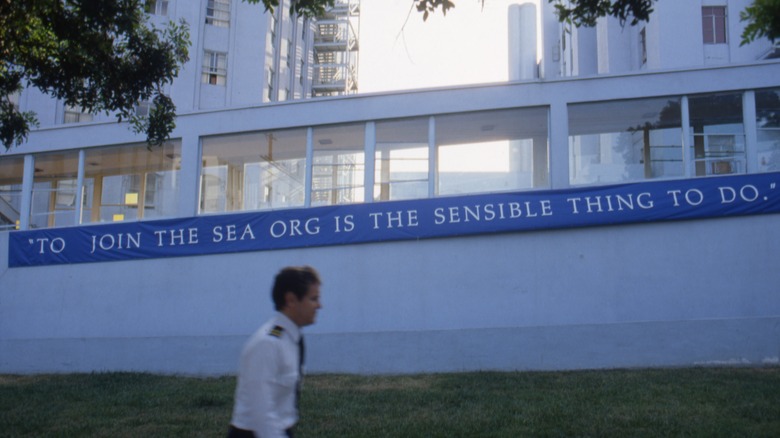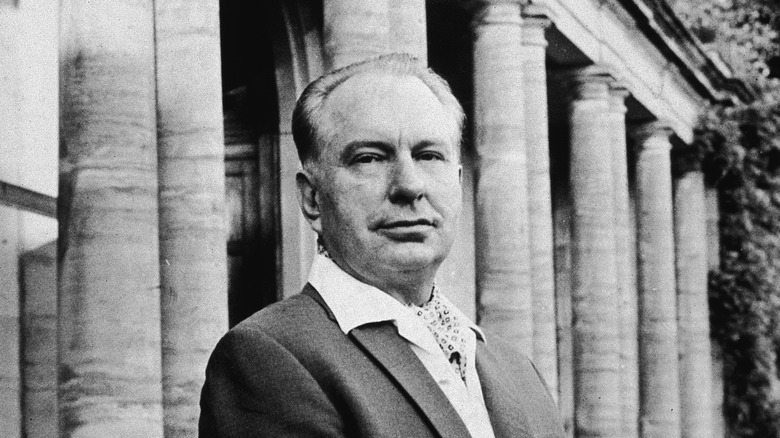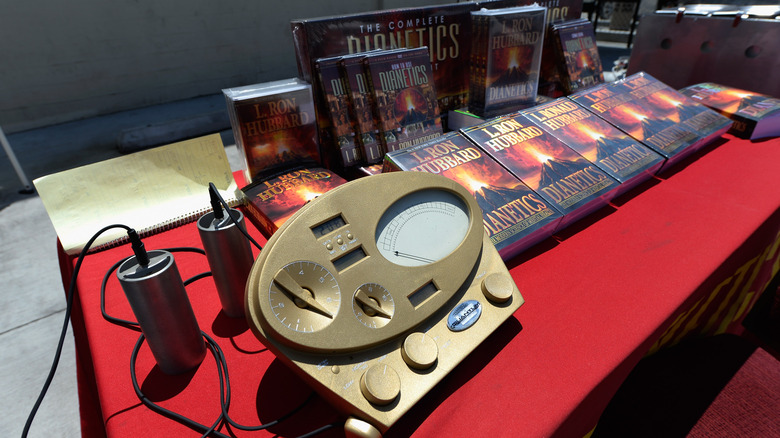Scientology's Project Rehabilitation Forces Explained
Starting in the 19th century, any religions that emerged became part of what is known as the new religious movement. According to Britannica, there are particular traits that movements and religions have that make them part of the new religious movement, of course, one of them being that they are new. These belief systems also tend to favor innovative approaches designed to help followers function in the modern world.
After World War II, one of the new religious movements' most well-known and controversial religions, Scientology, came into existence. Scientology was started by L. Ron Hubbard, a man who despite being one of the most prolific writers in history — he published over 1,000 books in his lifetime, per Guinness World Records — remains something of an enigma. The version of L. Ron Hubbard that he crafted that is still embraced by the Church of Scientology is completely divergent from the man on record. Everything from his eyesight to his war record differs depending on who you ask.
Still, Hubbard amassed a substantial following with some of the most high ranking becoming part of the Sea Organization, a sect within Scientology comprised of the most dedicated Scientologists. However that status doesn't make a Sea Org member impervious to punishment if they are found in violation of the church's expectations, and severe cases can even get them sent to Rehabilitation Project Force — an alleged prison camp used to give Sea Org members who have stepped out of line a second chance, per Center for Studies on New Religions, per Huffington Post.
Scientology's roots
L. Ron Hubbard was a copious writer and in the early part of his writing career, he wrote stories for science fiction pulp magazines. In 1950, he released a book called "Dianetics: The Modern Science of Mental Health" which laid out a series of techniques that Hubbard claimed he had used to cure himself of ailments he received during World War II. According to History, Dianetics became a massive success and even climbed to the top of the bestsellers list. Hubbard started setting up Dianetics groups all over the world.
Dianetics faced a stumbling block when the American Psychological Association questioned Hubbard's claims. He introduced a device called an electropsychometer, or E-meter, which measured electrical currents in a subject's hands. This gave Dianetics a more official, scientific look. By 1954, Hubbard settled on the name Scientology, and by 1954 he filed papers that made the Church of Scientology official, per the Center for Studies on New Religions.
The Sea Org
Next, Hubbard needed to spread the word about his new religious venture, and to do this he set up orgs, which functioned as churches or missions. He also bought a fleet of ships that became the Sea Org. Hubbard and the Sea Org traveled around the world for years starting in 1966, according to the Center for Studies on New Religions. It was originally called the Sea Project and it was intended to be an opportunity for Hubbard to expand upon his work and further develop Scientology and its teachings.
The Sea Org still exists today, although most of its members now operate on dry land. There is still a ship known as Freewinds that is based in the Caribbean that carries on the Sea Org's original nautical history.
According to Margery Wakefield's "Understanding Scientology," those wishing to join the Sea Org sign billion-year contracts, a mind-boggling term that ties into the Church of Scientology's belief system. They become highly respected among fellow Scientologists, but that doesn't mean that joining the Sea Org is a cakewalk, and running afoul of church policies can land a Sea Org some harsh punishments. This dates back to the original Sea Org voyage when Hubbard would order that a member be overboarded, which meant that they were thrown off the ship into the water. Another punishment involved locking the offender away in a confined space for long periods. Today, a Sea Org accused of breaking any of the Church's rules could wind up in the Rehabilitation Project Force, or RPF.
The Rehabilitation Project Force
While at sea in 1968, Hubbard set up the Mud Box Brigade which is regarded as a precursor to the RPF. Those deemed to not be pulling their weight were sent to clean the mud box, a part of a ship's bilge that filters water going into the suction pile, per Machinery Spaces. "More candidates will be appointed regularly and promptly every time I find a freeloader who is loafing on post and drifting with the wind," Hubbard wrote in "Modern Management Technology Defined."
Eventually, the Rehabilitation Project Force was introduced to serve as a similar, but expanded upon program, according to the book "New Religious Movements and Religious Liberty in America." Hubbard himself described the RPF's function like this: "The RPF is in actual fact a system of recruiting by taking people off the lines who are blocking things and then not letting them back on lines until they are a valuable operating staff member."
According to Dr. Stephen Kent from the Sociology Department at the University of Alberta, the Rehabilitation Project Force, or RPF, is a forced labor and re-education camp that serves as a way of punishing and rehabilitation (in the eyes of the Church of Scientology) members of the Sea Org. He further asserts that the program itself fits the social scientific criteria of brainwashing.
Life in the Rehabilitation Project Force
According to Hubbard's own words in "Modern Management Technology Defined" the Rehabilitation Project Force's Motto is "the RPF is what we make it. The RPF is where we make it." According to the University of Alberta, there are numerous Rehabilitation Project Force locations around typically housed at Scientology Centers around the world.
The Center For Studies on New Religions reports those sent to an RPF are there for around a year, and their days are typically split between eight hours of hard, forced labor, and five hours of studying and auditing, though some sources, like the HBO documentary film "Going Clear: Scientology & the Prison of Belief," allege that those at RPFs work for 30 hours at a time, before being given three hours off (via HuffPost).
Auditing is a Scientology technique involving an E-Meter. It's been alleged that some of those in an RPF are there against their will, and those in the program are often subjected to sleeping on floors and eating leftover food scraps. However, the Center For Studies on New Religions study noted that RPF facilities in both Denmark and England, while not particularly aesthetically pleasing, were considered to be clean and well stocked with necessary supplies, and members staying there found them to be satisfactory.
Criticism and defense of the Rehabilitation Project Force
The Rehabilitation Project Force has been a source of criticism from those outside of the Church of Scientology. Per Dr. Stephen Kent of the University of Alberta, those in the RPF are forbidden from having contact with their family. He argued was a direct violation of the Article 8 of the 1950 European Convention for the Protection of Human Rights and Fundamental Freedoms, which starts by saying "Everyone has the right to respect for his private and family life, his home and his correspondence."
According to the Hollywood Reporter, actress, and former Scientologist Leah Remini, interviewed former Scientologist Christi Gordon, for her documentary series "Leah Remini: Scientology and the Aftermath." Gordon — who had spent time in the RPF — told Remini, "The work got harder. Mostly it was the verbal abuse, I think, that was harder, that we were degraded beings and worthless, and that my mother would be better off without us."
According to Scientology Newsroom, the church's official media resource center, the RPF "program is physically and spiritually demanding and is done voluntarily for purposes of penance and amends." It also mentions that the program is devoid of luxuries and that while not all Sea Org members who enter it complete the program, most do.





